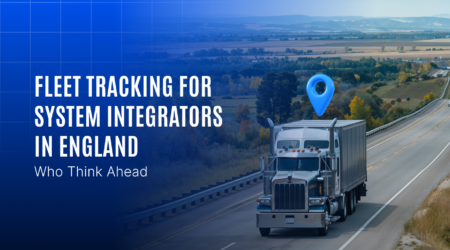ADAS System: Why it is Important?

In an era where technology is advancing at an unprecedented pace, the automotive industry is not left behind. The introduction and evolution of Advanced Driver-Assistance Systems (ADAS) have marked a significant milestone in this journey, revolutionizing the way we perceive and interact with vehicles. These sophisticated systems, designed to enhance vehicle safety and support the driver, are becoming increasingly integral in modern vehicles. In this blog, we delve deep into the realm of ADAS, exploring how they are changing the game and how they seamlessly integrate with advanced fleet management software like Trakzee.
Understanding ADAS: A Glimpse into the Future of Driving
Understanding Advanced Driver-Assistance Systems (ADAS) involves delving into the technologies that are transforming the driving experience by enhancing safety, increasing efficiency, and paving the way for the autonomous vehicles of the future. Here’s a more detailed look into what ADAS is, how it functions, and its implications for the future of driving.
What is ADAS?
ADAS refers to a range of systems and features in vehicles designed to help drivers and increase vehicle safety. These systems use a variety of sensors, such as radars, cameras, and lidar, to monitor the vehicle’s surroundings and provide information to the driver or even take action to avoid accidents and improve driving. They are a critical step towards fully autonomous vehicles, offering a glimpse of what future driving might entail.
Key Components of ADAS:
- Sensors and Cameras: These are the eyes of ADAS. Cameras capture visual information, while radar and lidar sensors detect the distance and speed of objects around the vehicle. This data is crucial for understanding the driving environment.
- Processing Units: High-performance computing units analyze the data from sensors and cameras in real-time. They make decisions based on algorithms and learned data patterns to assist or alert the driver.
- Feedback Systems: ADAS communicates with the driver through various feedback systems, which can be visual (like dashboard lights), auditory (alarms or voice prompts), or haptic (vibrations in the steering wheel or seat).
Core Features of ADAS:
- Adaptive Cruise Control (ACC): ACC adjusts the vehicle’s speed to maintain a safe distance from the vehicle ahead, using radar or lidar sensors.
- Lane Keeping Assist (LKA): LKA detects lane markings and helps keep the vehicle centered in its lane. It can provide steering input to correct deviations.
- Collision Avoidance Systems: These systems detect potential collisions with other vehicles, pedestrians, or obstacles and can automatically apply the brakes to prevent or mitigate a crash.
- Parking Assistance: Using cameras and sensors, these systems help drivers find suitable parking spaces and guide them into the spot, sometimes even controlling the vehicle entirely during the parking maneuver.
- Traffic Sign Recognition: Cameras recognize traffic signs and alert the driver to speed limits, no-entry signs, and other critical information.
The Impact of ADAS:
- Enhanced Safety: By reducing human error, the leading cause of accidents, ADAS significantly improves road safety. Systems like collision avoidance and lane-keeping assist prevent common accidents caused by distractions or driver fatigue.
- Increased Comfort and Convenience: Features like adaptive cruise control and parking assistance reduce the stress of driving, especially in challenging conditions like heavy traffic or tight parking spaces.
- Fuel Efficiency and Environmental Benefits: By optimizing driving patterns and reducing unnecessary acceleration and braking, ADAS can contribute to improved fuel efficiency and reduced emissions.
- Step Towards Autonomy: ADAS is a crucial stepping stone towards fully autonomous vehicles. As these systems become more sophisticated, they take over more driving tasks, leading to semi-autonomous and eventually fully autonomous driving.
Challenges and Considerations:
- Reliability and Limitations: While ADAS is advanced, it’s not infallible. Sensors can be obstructed by dirt, weather conditions, or other factors. Understanding the limitations and maintaining the systems is crucial for safety.
- Driver Overreliance: There’s a risk that drivers might become too reliant on ADAS, leading to inattention. Education and clear communication about the system’s capabilities and limitations are essential.
- Ethical and Legal Implications: As vehicles take over more driving tasks, questions about liability in accidents and ethical decisions in unavoidable crash scenarios become more prominent.
- Data Privacy and Security: ADAS systems collect and process vast amounts of data. Ensuring this data is secure and used ethically is a significant concern.
The Role of ADAS in Modern Vehicles
ADAS is not just an added luxury but a necessity in the modern automotive landscape. They serve as the eyes and ears of the driver, constantly monitoring the surroundings and providing real-time feedback. This proactive approach to safety helps in mitigating human errors, which are often the leading cause of road accidents. With the integration of sensors, cameras, and sophisticated algorithms, ADAS is paving the way for a safer and more efficient driving experience.
Trakzee: Elevating Fleet Management with ADAS Integration
Incorporating ADAS into fleet management systems like Trakzee is a game-changer for the logistics and transportation industry. Trakzee, an advanced fleet management software, harnesses the power of ADAS to provide a comprehensive and proactive approach to fleet safety and efficiency. By integrating ADAS, Trakzee offers enhanced features such as real-time vehicle monitoring, driver behavior analysis, and predictive maintenance alerts.
Enhancing Safety and Efficiency
The integration of ADAS elevates the safety standards of the entire fleet. For instance, collision warning systems alert drivers of potential threats, allowing them to react promptly. Lane departure warnings ensure that vehicles remain within their lanes, reducing the chances of accidents. Moreover, Trakzee’s analytical capabilities allow fleet managers to monitor and improve driver performance, further contributing to road safety and operational efficiency.
Trends in ADAS: Navigating the Road Ahead
As we look toward the future, several trends are shaping the evolution of ADAS. These advancements promise to make driving safer, more efficient, and more enjoyable.
The Rise of Autonomous Vehicles
One of the most significant trends is the gradual shift towards semi-autonomous and fully autonomous vehicles. ADAS is at the forefront of this transition, providing the foundational technologies that enable vehicles to drive themselves. As these systems become more advanced, we can expect vehicles to take over more driving tasks, ultimately leading to a future where cars drive themselves with minimal human intervention.
Integration with Artificial Intelligence
Artificial intelligence (AI) plays a pivotal role in enhancing the capabilities of ADAS. By integrating AI, ADAS can learn from vast amounts of data, improving their decision-making processes and adapting to new scenarios. This leads to smarter, more predictive systems that can anticipate potential hazards and take corrective actions even before the driver is aware of the threat.
Connectivity and Real-Time Data
The future of ADAS is also heavily reliant on connectivity. With the advent of the Internet of Things (IoT) and vehicle-to-everything (V2X) communication, ADAS can receive and analyze real-time data from various sources. This connectivity allows for more accurate and timely responses, further enhancing vehicle safety and efficiency.
The Benefits of ADAS: A Safer, Smarter Driving Experience
The benefits of ADAS extend beyond just safety. They contribute to a smarter, more efficient driving experience, making them an invaluable addition to any vehicle.
Reduced Accidents and Enhanced Safety
The primary benefit of ADAS is the significant reduction in accidents and enhanced safety for all road users. By assisting drivers in recognizing and responding to potential hazards, ADAS plays a crucial role in preventing collisions and other accidents.
Increased Comfort and Reduced Driver Fatigue
ADAS also increases comfort and reduces driver fatigue. Features like adaptive cruise control and lane-keeping assist reduce the need for constant manual control, allowing drivers to focus more on the road and less on the task of driving.
Improved Fuel Efficiency
Moreover, ADAS can lead to improved fuel efficiency. By optimizing driving patterns and reducing unnecessary acceleration and braking, these systems help conserve fuel. It benefits both the environment and the bottom line.
Embracing the Future: The Road Ahead for ADAS
As we move forward, the potential of ADAS is limitless. With continuous advancements in technology, the capabilities of these systems will only grow. It will lead to safer, more efficient, and more autonomous vehicles. The integration of ADAS with fleet management software like Trakzee signifies a step towards this future, offering a glimpse into a world where technology and safety go hand in hand.
The Importance of Staying Informed and Updated
To fully leverage the benefits of ADAS, it’s crucial for individuals and businesses alike to stay informed about the latest developments. Understanding the capabilities and limitations of these systems is essential for effective utilization and ensuring maximum safety and efficiency.
Conclusion: A New Era of Driving
Advanced Driver-Assistance Systems are more than just a technological innovation; they are a transformative force in the automotive industry. By enhancing safety, efficiency, and comfort, ADAS is setting new standards for what vehicles can achieve. The integration of these systems with sophisticated fleet management software like Trakzee is a testament to the potential of technology to revolutionize our roads. As we embrace these advancements, we move closer to a future where driving is safer and smarter, thanks to the wonders of ADAS.

